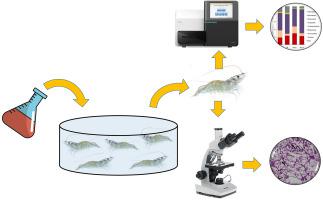当前位置:
X-MOL 学术
›
Aquaculture
›
论文详情
Our official English website, www.x-mol.net, welcomes your feedback! (Note: you will need to create a separate account there.)
Effect of rice bran fermented with Bacillus and Lysinibacillus species on dynamic microbial activity of Pacific white shrimp (Penaeus vannamei)
Aquaculture ( IF 4.5 ) Pub Date : 2021-01-01 , DOI: 10.1016/j.aquaculture.2020.735958 María A. Liñan-Vidriales , Alberto Peña-Rodríguez , Dariel Tovar-Ramírez , Regina Elizondo-González , Diana R. Barajas-Sandoval , Esther I. Ponce-Gracía , Carmen Rodríguez-Jaramillo , José L. Balcázar , Eduardo Quiroz-Guzmán
Aquaculture ( IF 4.5 ) Pub Date : 2021-01-01 , DOI: 10.1016/j.aquaculture.2020.735958 María A. Liñan-Vidriales , Alberto Peña-Rodríguez , Dariel Tovar-Ramírez , Regina Elizondo-González , Diana R. Barajas-Sandoval , Esther I. Ponce-Gracía , Carmen Rodríguez-Jaramillo , José L. Balcázar , Eduardo Quiroz-Guzmán

|
Abstract This study aimed to evaluate the effect of rice bran fermented with a consortium of Bacillus and Lysinibacillus strains (RB + BLb) on the bacterial community structure and composition in the gastrointestinal tract of Pacific white shrimp (Penaeus vannamei), as well as its effect on growth performance and health status. Rice bran fermented with a commercial probiotic (RB + Com) was also evaluated for comparative purposes. Rice bran with or without probiotics, pre-fermented for 24 h, was directly added to the rearing water of juvenile shrimp for 4 weeks. At the end of the experimental period, shrimp treated with RB + BLb had a slightly better shrimp growth performance and survival than the control group; however, the differences were not statistically significant (p > 0.05) among treatments. Moreover, histological analyses showed that shrimp treated with RB + BLb improved the nutritional status compared to other treatments, by inducing an increase in lipid reserves of hepatopancreas epithelial cells. The analysis of the bacterial community composition revealed that the most prevalent families were Rhodobacteraceae, Vibrionaceae and Flavobacteriaceae. Although sequences affiliated to the Rhodobacteraceae family were more abundant in shrimp treated RB + Com, a lower proportion of sequences affiliated to the Vibrionaceae family was found in shrimp treated with unfermented rice bran (RB) or RB + Com, when compared with the control group or those treated with RB + BLb. The abundance of sequences affiliated to the Flavobacteriaceae family was significantly lower in shrimp treated with RB + BLb or RB + Com than the control group or those treated with RB. These results could explain, in part, the mechanisms of action whereby the use of rice bran fermented with a consortium of probiotic bacteria confer beneficial effects on shrimp culture.
中文翻译:

芽孢杆菌和赖氨酸杆菌发酵米糠对南美白对虾(Penaeus vannamei)动态微生物活性的影响
摘要 本研究旨在评价芽孢杆菌和赖氨酸杆菌联合体(RB + BLb)发酵米糠对南美白对虾(Penaeus vannamei)胃肠道细菌群落结构和组成的影响及其影响。生长性能和健康状况。出于比较目的,还评估了用商业益生菌 (RB + Com) 发酵的米糠。含或不含益生菌的米糠,预发酵 24 小时,直接加入幼虾的养殖水中 4 周。实验结束时,RB+BLb处理的虾比对照组的虾生长性能和成活率略好;然而,治疗之间的差异没有统计学意义(p > 0.05)。而且,组织学分析表明,与其他处理相比,用 RB + BLb 处理的虾通过诱导肝胰腺上皮细胞脂质储备的增加来改善营养状况。细菌群落组成分析表明,最普遍的科是红杆菌科、弧菌科和黄杆菌科。虽然属于红杆菌科的序列在 RB + Com 处理的虾中更丰富,但与对照组相比,在未发酵米糠 (RB) 或 RB + Com 处理的虾中发现的属于弧菌科的序列比例较低或那些用 RB + BLb 治疗的人。RB + BLb 或 RB + Com 处理的虾中黄杆菌科序列的丰度显着低于对照组或 RB 处理的虾。这些结果可以在一定程度上解释使用益生菌菌群发酵的米糠对虾养殖产生有益影响的作用机制。
更新日期:2021-01-01
中文翻译:

芽孢杆菌和赖氨酸杆菌发酵米糠对南美白对虾(Penaeus vannamei)动态微生物活性的影响
摘要 本研究旨在评价芽孢杆菌和赖氨酸杆菌联合体(RB + BLb)发酵米糠对南美白对虾(Penaeus vannamei)胃肠道细菌群落结构和组成的影响及其影响。生长性能和健康状况。出于比较目的,还评估了用商业益生菌 (RB + Com) 发酵的米糠。含或不含益生菌的米糠,预发酵 24 小时,直接加入幼虾的养殖水中 4 周。实验结束时,RB+BLb处理的虾比对照组的虾生长性能和成活率略好;然而,治疗之间的差异没有统计学意义(p > 0.05)。而且,组织学分析表明,与其他处理相比,用 RB + BLb 处理的虾通过诱导肝胰腺上皮细胞脂质储备的增加来改善营养状况。细菌群落组成分析表明,最普遍的科是红杆菌科、弧菌科和黄杆菌科。虽然属于红杆菌科的序列在 RB + Com 处理的虾中更丰富,但与对照组相比,在未发酵米糠 (RB) 或 RB + Com 处理的虾中发现的属于弧菌科的序列比例较低或那些用 RB + BLb 治疗的人。RB + BLb 或 RB + Com 处理的虾中黄杆菌科序列的丰度显着低于对照组或 RB 处理的虾。这些结果可以在一定程度上解释使用益生菌菌群发酵的米糠对虾养殖产生有益影响的作用机制。



























 京公网安备 11010802027423号
京公网安备 11010802027423号